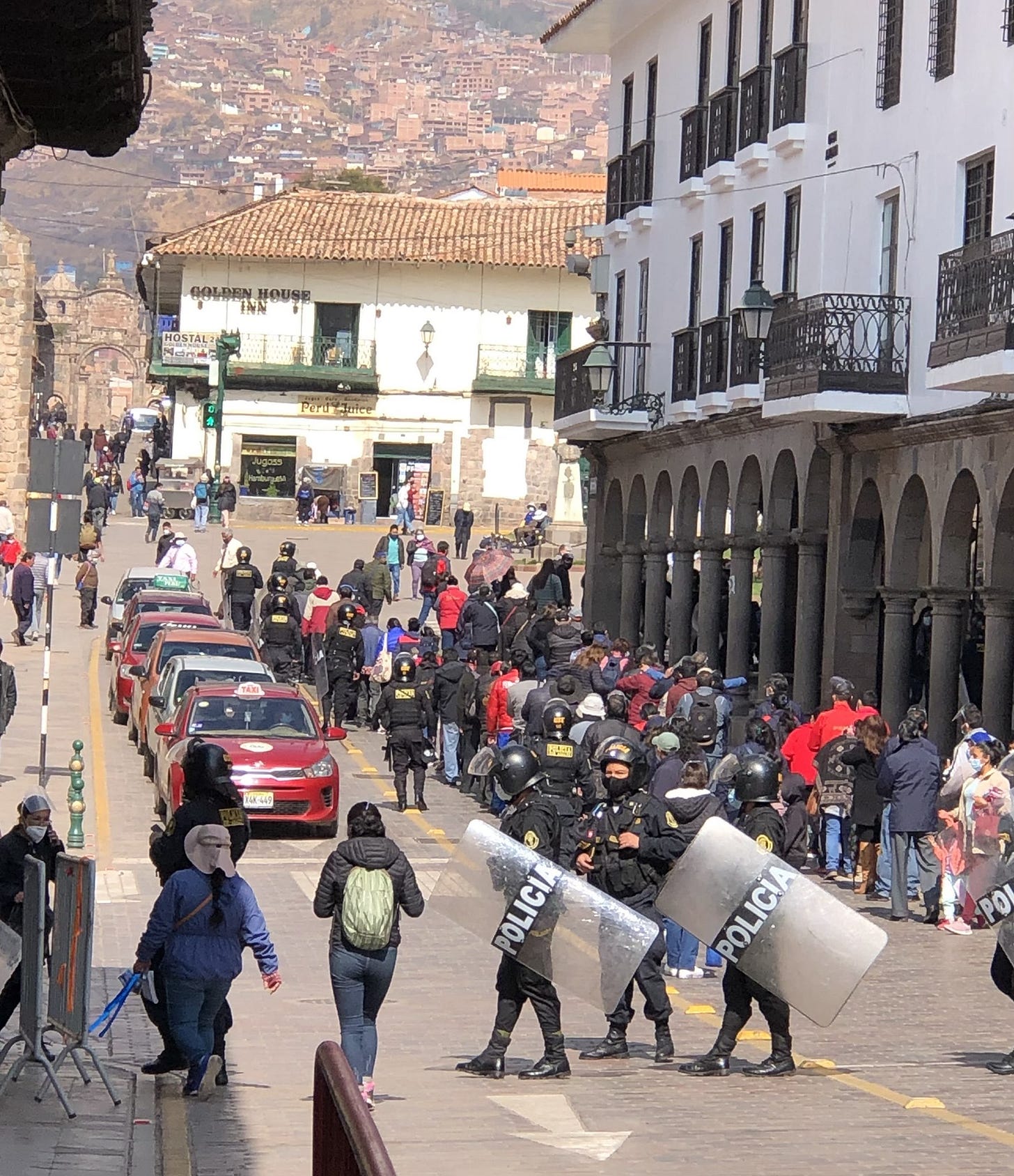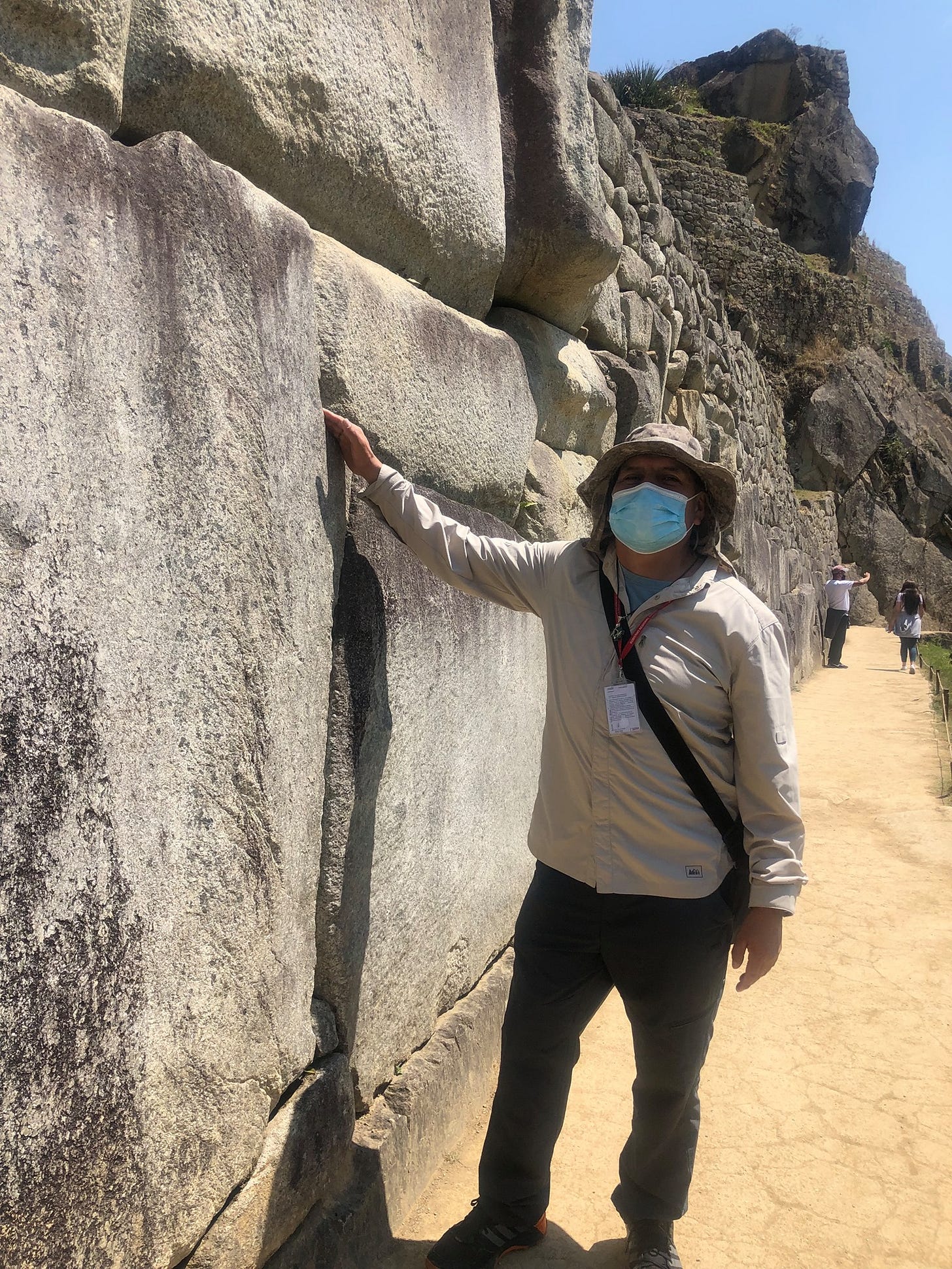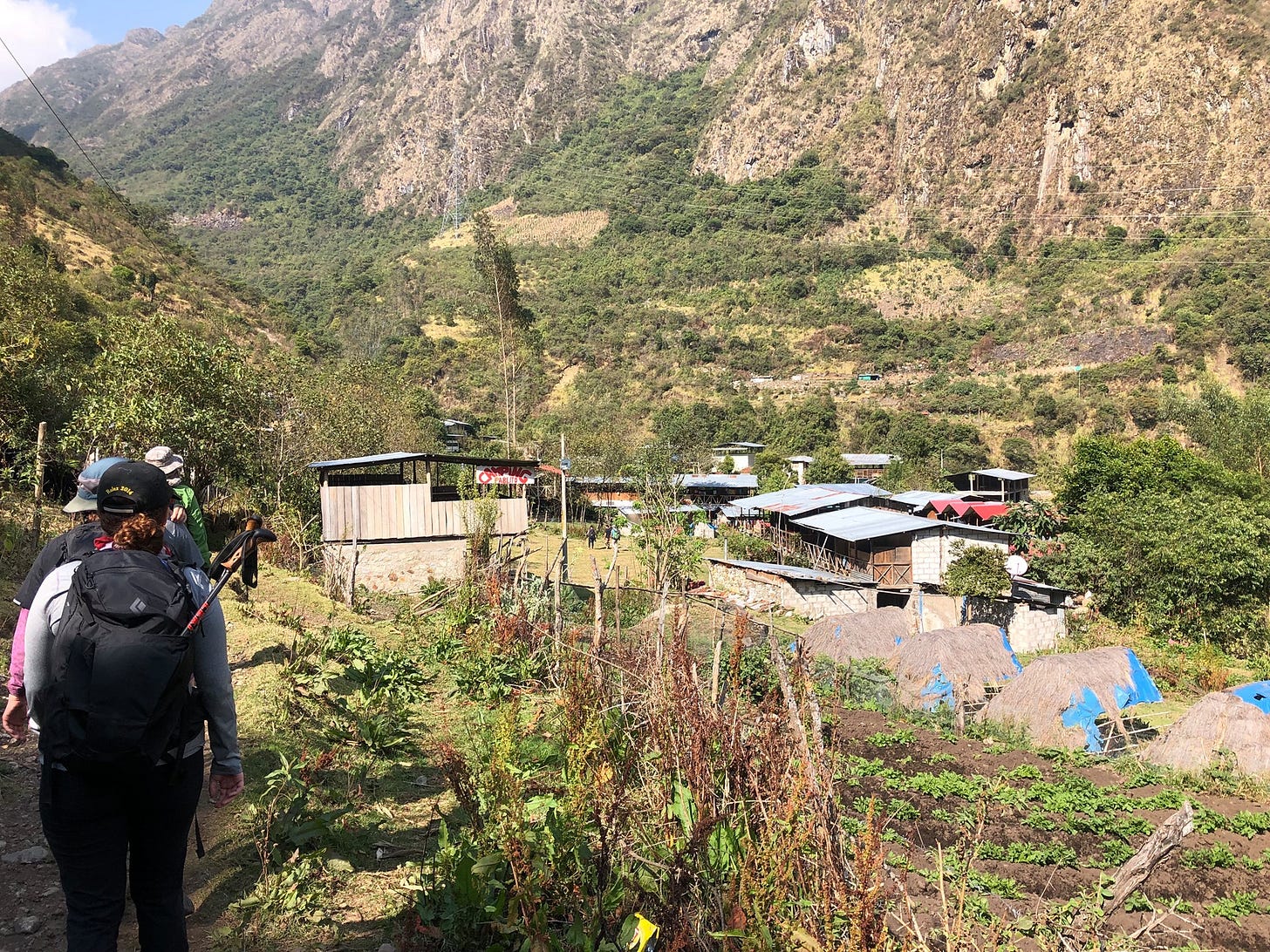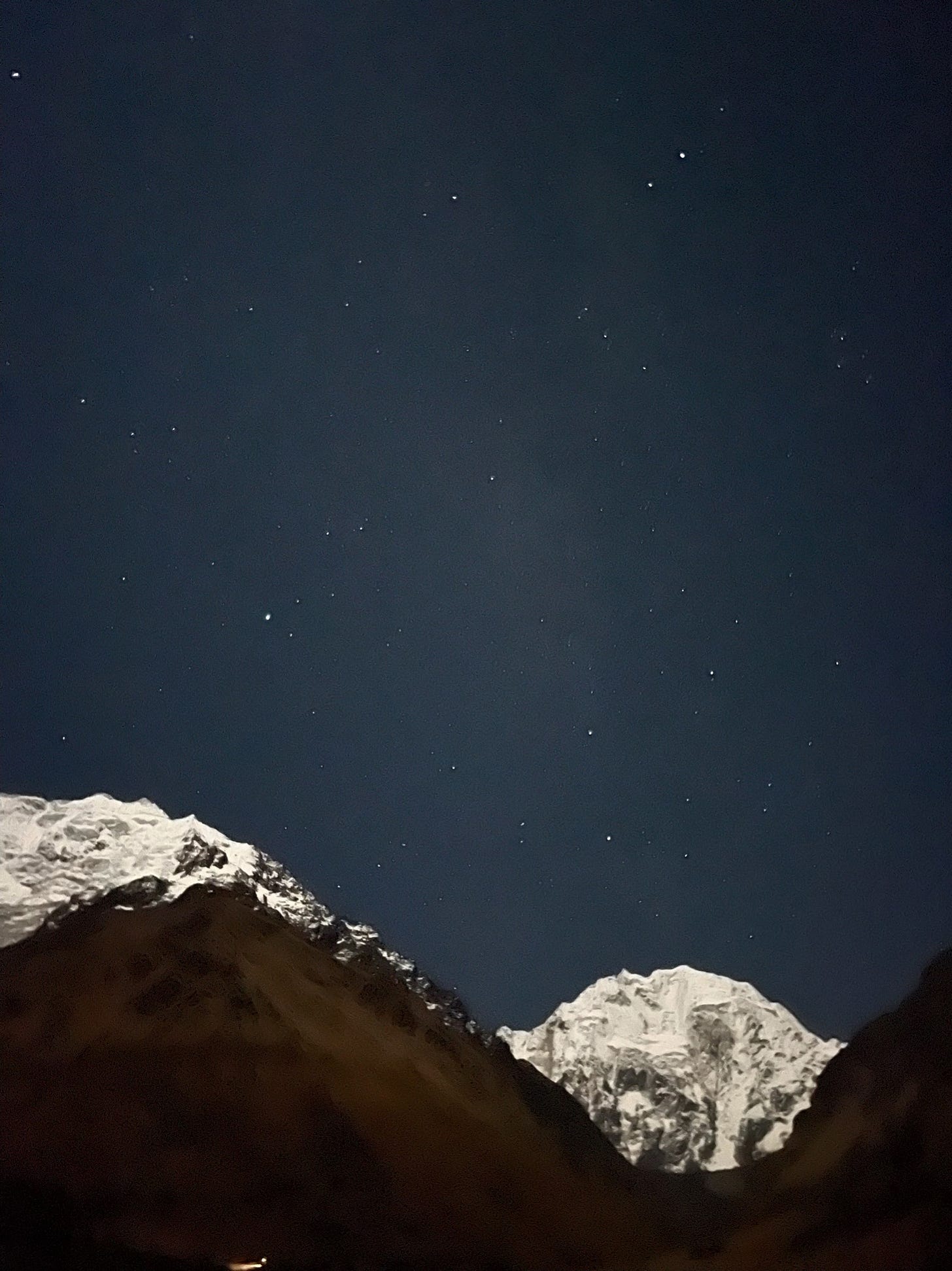
It’s 9 a.m. and the weather is perfect. The sky is aquamarine. Scattered clouds provide occasional respite from the sun’s heat. The horizon seems to have rotated 90 degrees to make the landscape more vertical than horizontal. Everything is peaks and valleys, ups and downs.
After walking up a seemingly endless set of stone steps, I finally see it — Machu Picchu, voted one of the “new” Seven Wonders of the World.
It’s breathtaking. Literally and figuratively.
Machu Picchu is a very powerful place, not just because of its strategic setting among important Andean peaks which are called “Apus,” meaning “Lords.” There is a certain spirituality here, but what strikes me most is the tremendous amount of engineering, civil planning, hydrology, astronomy and agriculture that went into the creation of this unique mountaintop compound. No one knows why Machu Picchu was abandoned, but it remains the only city in the Inca empire untouched by Spanish conquistadors.
They didn’t even know it existed.
Machu Picchu was presumably commissioned by Pachacuti sometime in the mid-1400s. He’s considered the most forward-thinking Inca ruler, who expanded the empire into what is now Bolivia. Eventually his descendants would rule parts of Colombia, Ecuador, Chile and Argentina, creating the largest civilization in the pre-Columbian Americas.
Pachacuti was a great builder, and amazingly, all of the surviving structures you see around Peru were created without traditional tools. Stones were moved over long distances and hauled up great heights without wheels. The Inca never figured out the wheel, and how they built such magnificent cities without it is something I still can’t get my head around.
I’m with four friends the morning we spend in Machu Picchu, and we are winding our way through the 15th-century marvel with a few hundred other tourists — a fraction of what would normally be here pre-pandemic. All of us are wearing masks, which is no easy feat at 8,000 feet. Some of us briefly remove our masks when being photographed, and then a Peruvian park ranger blows his whistle and threatens to kick us out.

Before we got busted.

After we got busted.
We appear to be the only Americans here. At least, we’re the only people speaking English. Nearly everyone else seems Peruvian.
The other half of our group ascended to Machu Picchu a few hours ahead of us in order to catch an earlier flight home.
They had the place to themselves.
Can you imagine?

Just you and Machu Picchu.
COVID’S DEADLIEST COUNTRY
Peru was hit harder by Covid than any other major economy. Nearly 200,000 Peruvians have died of the virus, the deadliest per capita rate in the world.
By August 2020, over 90% of Peruvians employed in the tourism industry were out of work. The country went into a tight lockdown; some tourist areas still remain closed or have reduced hours.
I gotta tell ya, these people don’t mess around when it comes to masks. You have to be doubled-masked at airports and wear a mask plus face shield to board a bus or train.
Again, not fun at high altitude where it’s already a challenge to breathe.

Not my best look.
On top of all this, Peru is emerging from a hotly contested election which put left-leaning Pedro Castillo in power. Castillo won by 44,000 votes, or a margin of 0.25%.

Peruvian President Pedro Castillo
His administration is off to a rough start, with a low 38% favorability rating. The Peruvian Congress is led by the opposition party which appears unlikely to approve Castillo’s new cabinet. Far-right members accuse the new Labor and Prime Ministers of supporting the Shining Path terrorist organization which tormented Peru for decades.

A street protest during my last day in Cusco.
However, Bloomberg reports Peru made a “record comeback” in the second quarter this year. GDP soared 42% as the country benefited from high copper prices, its biggest export.
Still, this is where the Lambda variant of Covid was first identified. You’re probably thinking I was crazy to travel to Peru right now, but hey, what better time for a vaccinated person who takes reasonable precautions to see one of the most amazing places on the planet?
Over seven days, my friends and I hiked about 40 miles through the Andes and “Cloud Forest” until we reached Aguas Calientes, gateway to Machu Picchu. We ascended to an altitude of 15,200 feet at the Salkantay Pass before descending to 6,000 feet among coffee plantations, butterflies and mosquitoes. It’s hard to believe you’re in the same country when passing through such starkly different environments, much less doing it in just 15 miles.
Out on the trail we didn’t have to wear masks, thank goodness. I was sucking up all the oxygen from two time zones just to survive each day. Hot tip: Chewing coca leaves actually does help. They don’t make you high, but they do give you a nice jolt of energy. Just don’t swallow them like I did. Trust me.

At the Salkantay Pass.
I also learned on the trail that Peruvians adapt and thrive. They have to.
“I am ambitious, but I am also a little afraid.”
Miguel Alata and Carlos Loayza were our guides. Both have families to support, and both were forced to find other jobs or learn new skills over the last year when tours evaporated.

Miguel Alata inside Machu Picchu.
Miguel studied computer science in college, but when he took on some tech work for a local tour company, guides asked him to join them on a trek.
He was hooked. He stopped studying computers and switched to tourism.
He’s from Cusco, the original capital of Peru, the place where Francisco Pizarro arrived with conquistadors searching for gold in 1532. The sight of light-skinned men on horseback reportedly confounded the locals, who could not ride a llama or alpaca. They assumed man and horse were one being, a centaur.
In any case, as you’re probably aware, it didn’t end well for the Incas.
The Spanish eventually moved Peru’s capital to Lima to be closer to the ocean, for trade and communication with Spain back home. Miguel says folks in Lima are proud of their Spanish heritage, while people in Cusco are proud of being Quechua (which is the actual name of the indigenous people — “Inca” only refers to the leader). The Quechua language is not taught in schools, but it’s still spoken up in the mountains, and Miguel went to live with his grandparents to learn it.
“My grandmother refused to ever get in a car,” he says with a laugh. “She would rather walk.” Grandma lived to be 105 and died in her sleep.
I need to walk more.
But the pandemic nearly destroyed Miguel’s career. His wife is also in the tourism industry, and they made ends meet over the last 17 months by becoming delivery drivers. Yes, DoorDash and Uber Eats have made it to Peru.
It’s also been a rough year for fellow guide Carlos Loayza, who is also from Cusco. Carlos was brought up in the tourism industry. His mother used to sell trips, and she would dress him up in local outfits as part of her sales pitch. However, Carlos studied economics at university, hoping to make a better living.
He soon discovered his heart wasn’t in it.
Anyone who gets to know Carlos soon realizes his heart is in the Andes.
Carlos started doing accounting work at a tour company while still in college, and when the guides would come into the office, he’d think, “That’s the life, being outdoors.”
Eventually he decided to dump accounting and switch to studying tourism.

Carlos Loayza is front row on the left.
His mother was furious.
“I’ll never forget what she told me,” he said one day while we were hiking: “‘Do not have any regrets.’”
Over the last year, he’s had regrets. Even with his wife working as a teacher, it’s been difficult to pay the mortgage. Carlos acknowledges he would’ve made more money with a steadier job if he’d stayed in accounting.
Yet he took the extra free time during the pandemic to discover a new skill. Carlos recently started hosting videos for local government agencies explaining the importance of certain cultural sites. I think he’s actually pretty good, and I should know (I’ve been on camera for almost 40 years).
“I would have never done this if there had been no Covid,” Carlos told me.
Now he has higher ambitions. Carlos is trying to build a brand, and a tour company in Canada recently asked him to move there for work. He might do it for a year in order to start networking, with the goal of eventually creating his own tour company back in Peru catering to families.
“I am ambitious, but I am also a little afraid.”
I told him to go for it, but that’s easy for me to say. This would be the biggest risk he’s ever taken.
THE ANDEAN SIDE HUSTLE
Living in the Andes carries its own risks. Most people are farmers, and many of them developed tourist-related side hustles which suffered significantly during Covid.
Some made extra money as porters for groups like mine, using horses to carry water or duffel bags. Others invested in new shelters on their farms for backpackers, providing toilets and hot showers.

A local farm added shelters for backpackers.

In addition to accommodations, she charges $2.50 for me to take her photo. Ka-ching!
Luis Canela went even further.
Canela began as a porter for tourists. Then he started growing coffee, and he eventually invited the guides over to his small farm to taste his freshly roasted Peruvian brew.
It was a hit. It’ll also put hair on your chest. Who needs coca leaves?

Luis Canela roasts coffee beans.
Now Canela doesn’t need to be a porter. His small coffee farm has grown into a larger enterprise which produces 2,700 pounds of beans a year. He sells them to manufacturers in the town of Santa Teresa.
He also makes a killer kahlua from his own sugarcane-based moonshine, coffee, and honey.

Peruvian Kahlua. Yummmmmm.
“Mi Peru”
As impressive as Machu Picchu and Salkantay are, I was equally impressed by the Peruvians themselves. To a person, they were congenial and low-key. Even the street hawkers in Cusco didn’t push too hard. “Señorita, would you like to see my paintings?” I’d be asked. “No, gracias.”
“Ok, maybe tomorrow. My name is Julio.”
(Don’t worry, I spent plenty of money in Peru.)
However, as friendly as everyone appears to be, this is not a country that feels united. I’m not even talking about the years of violence and terror caused by the Shining Path. Miguel tells me some people from Lima look down on those from Cusco as lower class and uneducated, while those in Cusco are proud of their heritage and don’t like the “Spaniards” from the capital. Then there are the millions of Peruvians living in the countryside, from the Andes to the Amazon, each from their own region, each wearing their own particular clothing.
How do you make them feel as one?
One night at the end of a long day, Carlos sang a song which he said helped unite the country a half century ago, a song written by Manuel Raygada called “Mi Peru.” He sang in Spanish, but here are some of the lyrics in English.
“I am proud to be Peruvian, and I am happy to have been born in this beautiful land of the sun.”
Carlos became emotional, his voice cracking as he sang the chorus.
“Rich mountains, beautiful lands, laughing beaches, it is my Peru. Fertile lands, snowy peaks, broken rivers, it is my Peru.”
His rendition was a slower and more melancholy version of the upbeat original, which I found on Youtube.
Finally, at the end of our trek, I asked Miguel and Carlos when they would lead their next tour.
“I don’t know,” they both told me. It could be weeks, or months. In the meantime, they’ll spend time with their families, hustle to make ends meet, and wait for a phone call from the tour company sending them back into the Andes, their favorite place in “su Peru.”

Salkantay at night.
Thanks to my co-trekkers for letting me use their photos, including Scott Douglas, Maddie McCarthy, Mark Partin and Grace Partin.
Are you ready to see the world yet? Am I an idiot for doing so? Feel free to comment or email jane@janewells.com, and spread the word to subscribe to Wells Street!




